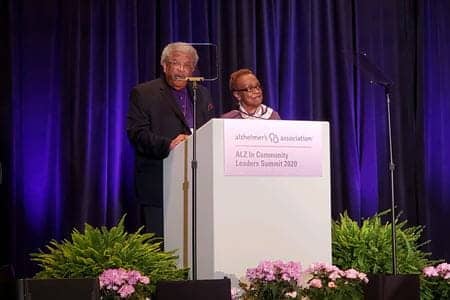Dementia researchers want study cohorts to ‘look like America.’ A pioneering push to proportionately represent excluded groups in research faces an uncertain future.
What happens when Alzheimer’s — a disease that strikes minority communities the hardest — is largely studied in well-educated whites? Is Alzheimer’s research one-size-fits all, or do we need research cohorts that truly reflect the incredible patient diversity that doctors see every day?
These are some of the questions that the Alzheimer’s Disease Neuroimaging Initiative (ADNI) aims to tackle with its newest incarnations, ADNI-4 and ADNI For All, Dr. Michael Weiner said at the 2025 AD/PD conference in Vienna, Austria.
Weiner, a professor of radiology at the University of San Francisco, California, launched ADNI in 2004. The world’s largest observational study on Alzheimer’s, ADNI has completed three study periods and enrolled more than 2,500 participants. The team’s research into fluid and tissue biomarkers and brain imaging underpins many of the field’s pivotal advancements, including new anti-amyloid antibody therapies that clear plaques from the brain and are associated with a slowing in the rate of disease progression.
But ADNI’s participants — like cohorts in many Alzheimer’s studies — have always been a pretty homogenous bunch, mostly white and well-educated. This is a common drawback for many Alzheimer’s and dementia studies, making it harder to understand what’s causing diseases like Alzheimer’s and whether drugs and diagnostics are actually effective, according to Emory University cognitive neuroscientist Whitney Wharton. Wharton researches the connection between vascular health and Alzheimer’s, and until February, she held a multi-million dollar federal grant to study ways to get more LGBTQ participants into Alzheimer’s studies (because studying the disease’s targeted populations leads to a better understanding for all).
Study populations that reflect the real world
ADNI-4 — ADNI’s current iteration — is seeking to change this problem of homogenous research cohorts. Launched in 2023, the ADNI-4 trial employs targeted multi-lingual community outreach to reach potential participants from under-represented communities. Initially, ADNI-4 had 438 participants; just 29 percent were ethnic and cultural minorities, people with less than a high school education, or living in rural communities.
Now, however, the study has enrolled 300 additional people, 63 percent of whom come from those groups. Overall, 43 percent of the ADNI-4 cohort are members of under-represented communities. That’s a key accomplishment, because these groups are up to twice as likely to develop Alzheimer’s as compared to whites.
“We want to make ADNI look like America, because if we’re going to have diagnostics and treatments for the whole population, we need to understand the disease in the whole population.”
Education is still a missing piece
The ADNI-4 team is growing closer to their trial being truly representative of the real-world population. But according to Weiner, they are still struggling to address educational disparity in the enrollment group. About half of the U.S. population 65 and older completed 12 years of school, but among the ADNI-4 participants, about 90 percent have at least a high school degree, and half have an advanced degree.
Like societal differences, educational differences also affect Alzheimer’s risk. Multiple studies confirm that lower educational attainment (which is closely linked to lower socioeconomic status) can increase a person’s risk for many diseases, Alzheimer’s and other dementias included. The reasons for this association are various, including that people who have less access to education also likely have less access to quality healthcare, less awareness of preventive strategies, and poorer physical health, said Weiner.
ADNI For All has the potential to usher in that change, exploring ways to enroll more participants with lower educational and socioeconomic levels. Investigators will collaborate with the Clinical Directors Network, which works with Federally Qualified Health Centers — primary care centers largely funded by Medicaid, the federal insurance program for low-income citizens.
“There are something like 70 million people in the U.S. on Medicaid right now,” Weiner said. “These people do not have private health insurance and many of the seniors don’t even have Medicare. No AD research has ever been done on a large scale with federally qualified health clinics and their populations.”
The ADNI team wants to enroll up to 200 participants, with at least 50 percent of them undergoing brain imaging. “We will start enrollment in late 2025 and into 2026, and hope to have results by 2027,” Weiner said.
Weiner hopes data from ADNI For All will support the federal grants that will keep ADNI going into its next iteration, ADNI-5, slated to start in 2027.
New threats to inclusive research
The big unknown, however, is where federal funding for research might be in two years — especially when it comes to funding for research on diverse populations. The Trump administration has ordered large-scale reviews of all research that includes anything interpretable as “diversity, equity, or inclusion.”
While nothing has yet changed for ADNI, a purple banner recently appeared on its main web page, saying “This repository is under review for potential modification in compliance with Administration directives.”
Weiner declined to speculate on what this federal-level review might mean for ADNI, a project that has dedicated 21 years to discovering both commonalities and differences in the devastating puzzle of Alzheimer’s risk and progression.
“I really have no information, and no idea,” he said in an email. “I have no knowledge other than what everyone reads in the newspaper, about how federal funding is going to be changed and how it might affect our research.”
But Wharton does have an idea.
In February, she was three and a half years into her four-year, $3 million grant looking at how to recruit more LGBTQ people into studies on aging, including Alzheimer’s. Several studies have shown that these people are at increased risk for cognitive decline and dementia, but, Wharton said, they are extremely under-represented in clinical trials.
“Racial and ethnic minorities and LGBTQ individuals often participate in clinical research at lower rates than non-Hispanic white individuals.” she told Being Patient. “It’s a combination of historical, structural, and sociocultural barriers including historical mistrust, fear of discrimination, barriers to access (not having access to healthcare or research centers, reliable transportation or not being able to take off work), and shortfalls of clinical studies and trials who could do more to actively engage and recruit minoritized communities.”
Wharton’s was the first nationally funded project to improve the LGBTQ presence in aging studies — and a study the National Institutes on Aging specifically requested.
Yet, on Feb. 28, she received a grant termination letter from the National Institutes of Health.
“I was just checking my email that evening and there it was. A two-page letter saying the grant was terminated immediately. It said, ‘This award no longer effectuates agency priorities. NIH is obligated to carefully steward grant awards to ensure taxpayer dollars are used in ways that benefit the American people and improve their quality of life. Your project does not satisfy these criteria … research programs based on gender identity are often unscientific, have little identifiable return on investment, and do nothing to enhance the health of many Americans. Many such studies ignore, rather than seriously examine, biological realities. It is the policy of NIH not to prioritize these research programs.’”
What Can We Learn About Dementia from LGBTQ+ Brain Health Research?
Although she’s appealing the decision, Wharton doesn’t hold out much hope. She took down the study website, cancelled the contracts for statistical work that would have analyzed the data, and remains in waiting mode.
“We had already spent more than $1.7 million and the rest was going for our statistical analysis and community resources. But if we’re not able to analyze and publish these results and finish what we started, that essentially is wasting all of that taxpayer money.”
Ironically, Wharton added, she designed the study specifically in line with NIA’s request for research projects just like this.
Her grant application package contained letters of support from more than 25 academic institutions with Alzheimer’s Disease Research Centers and from the Alzheimer’s Association.
“To go from that and the wonderful scientific and community response we had to this, is such a 180,” she said. “It’s absolutely gutting.”




